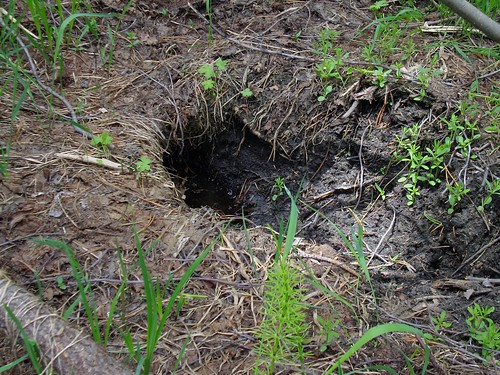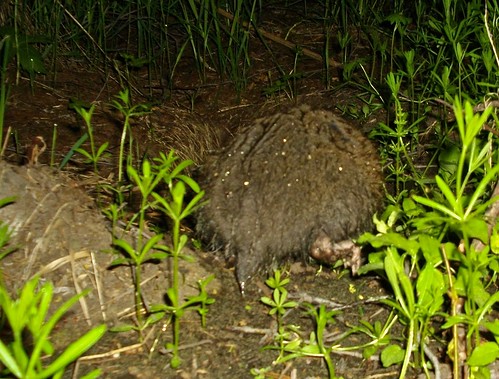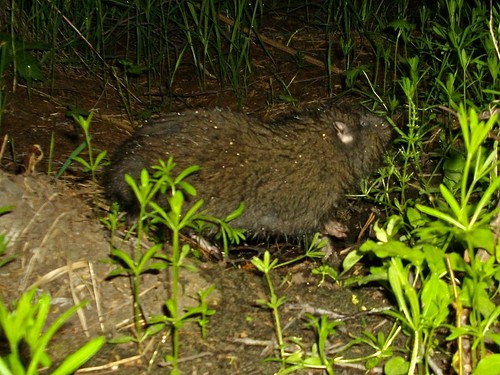Boomer.
Showtl.
Aplodontia.
PC (Pre-Codger), I had only vaguely heard of these elusive, poorly monikered rodents.
But when we pulled Codge's preset cams during last year's cam trapping class, and saw photos of the marvelous beastie, I knew that I too wanted a crack at catching their grin.
So, this year, as part of Codger's pre-class sets, I sunk a cam at a highly likely burrow:

Cam trap on aplodontia burrow in alder grove along Yuba River

They eat and collect bark and twigs - hence the "mountain beaver" nickname
The term "living fossil" is soooooo wonderfully exemplified by these fascinating rarities. The oldest living rodents, and the only members of their family and genus sill alive, molecular biology and fossil records are showing that the Aplodontidae split from the squirrel family about 40 million years ago, during the Eocene epoch.
Yes, the squirrel family. They're big, shaggy, mud-loving, slow-shuffling, nocturnal ground squirrels. Or, perhaps marmots, which are also old and related to squirrels, are a better comparison. But they're definitely not beavers.
My shy showtl did show - but only 3 times in 30 days, and not until the 6th night...

That ain't no beaver tail...

Bingo! An adult Aplodontia rufa is 16 inches long, and weighs about 1-1/2 pounds

Check out those human-like ears and tiny, heavy-lidded eyes

Burrow full of water? No prob for a rodent that builds chambers that trap air

20 days later - its natural privacy screen is fully up
A good first try at these shy guys.
I'm looking forward to another go next year.
====
References:
- Wikipedia - Aplodontia
- Wikipedia - Eocene
- Wikipedia - Marmot
- Smithsonian National Museum of Natural History - Aplodontia rufa
- Camera Trap Codger - Annual Aplodon Photos
- Camera Trap Codger - posts on Aplodontias

interesting little guy. haven't heard of him before now.
ReplyDeleteGreat pictures. Congratulations! I would love to see one. (So far have only found burrows - they are a species at risk up here.)
ReplyDeleteWow, that's super exciting. They are SO intriguing! =) I'm very glad you are looking into them to learn more. I didn't remember that they're the most ancient species of rodent alive?!? I assume, then, that they are generalists?
ReplyDeleteAnyhow, very cool. And thanks SO MUCH for sharing! =)
Yes, they're a Near Threatened species here too, I think. And/or a Species of Special Concern. Several of the subspecies might even be endangered. Their habitats are shrinking...
ReplyDeleteBB - they aren't a predecessor rodent species per se - their family branched off from squirrels in the evolutionary bush long ago, and hasn't really changed much since. Whereas the other species that came about at that time have since died off or changed dramatically.
Great pics and a great critter!
ReplyDeleteNicely done, RT!
sweet grabs Ken! You really nailed quite a few poses there. As always, great job!
ReplyDeleteLast I'd read about boomers, they were still annoying foresters and tree farmers here in the Pacific Northwest (by eating seedlings and girdling/killing young trees)--but given the other comments from PNWers about their local status, I'm going to have to check to see if boomers are still as numerous around here as they were several years back.
ReplyDeleteAnyway, another interesting thing about them is that they host the world's largest flea--a sucker 3/8th of an inch long.
--Patricia Lichen
http://www.patriciaklichen.com/
Wow, very interesting. Here in the Eastern Sierra our wildlife rescue center just received one picked up on the road injured near Mammoth. Here is a video of it:
ReplyDeletehttp://www.youtube.com/watch?v=W6LyyvAIPAg&feature=share